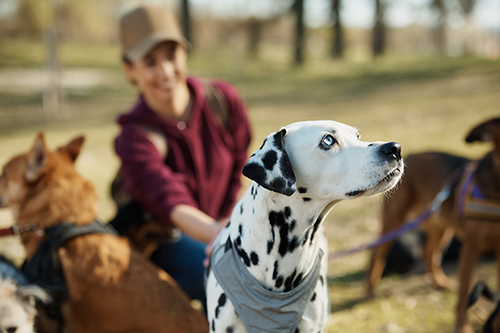Teaching Tricks to Dogs: A Step-by-Step Guide for Pet Owners
- blogs
- October 2, 2023
- admin
Begin with simple tricks that match your dog’s age, physical abilities, and personality. Sit, stay, shake paws, and roll over are great starting points.
2.Positive Reinforcement:
Use positive reinforcement techniques such as treats, praise, and affection to reward your dog for successfully performing a trick. This encourages them to associate tricks with positive experiences.
3.Timing is Key:
Mark the desired behavior with a marker word (like “yes” or “good”) or a clicker, followed by an immediate reward. This helps your dog connect the behavior with the reward.
4.**Break It Down:**
Break the trick into smaller steps. For instance, when teaching “roll over,” start by having your dog lie down on one side before progressing to the full roll.
5.Use Visual and Verbal Cues:
Pair visual cues (hand signals) with verbal cues (commands). Consistency in cues helps your dog understand what you’re asking them to do.
6.Short, Frequent Sessions:
Keep training sessions short and engaging. Aim for 5-10 minutes, a few times a day, to maintain your dog’s interest and prevent them from becoming bored.
7.Stay Patient:
Every dog learns at their own pace. Be patient, and avoid becoming frustrated if progress is slow. Celebrate even small achievements.
8.Fade Out Lures:
If you’re using treats as lures, gradually reduce their frequency to avoid your dog becoming dependent on them. Eventually, rely solely on praise and rewards.
9.Practice Regularly:
Consistency is key. Regular practice helps reinforce the learned tricks and prevents your dog from forgetting them.
10.Use Capturing and Shaping:
Capturing involves rewarding your dog when they naturally perform a behavior, like sitting down. Shaping involves rewarding incremental progress toward the final trick.
11.Add Challenges:
Once your dog has mastered a trick, add challenges like distractions or performing the trick in different locations to solidify their understanding.
12.Know When to Quit:
If your dog is tired, frustrated, or not showing interest, end the training session on a positive note. It’s important to keep training a positive experience.
13.Enjoy the Process:
Teaching tricks is a fun and bonding experience. Enjoy the journey and celebrate your dog’s accomplishments.
Teaching tricks to dogs is a fulfilling endeavor that enhances their mental and physical well-being while strengthening your bond. Remember that each dog is unique, so be flexible and adapt your training approach to their individual learning style. With patience, positive reinforcement, and consistent practice, you’ll watch your dog proudly demonstrate their newfound tricks, showcasing their intelligence and your shared accomplishments.

